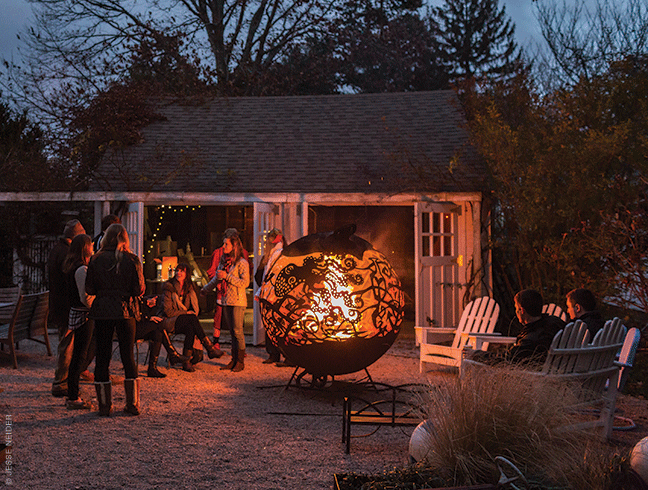
Class of ’85 | The dark orb rests on its side like an oversized bauble cast ashore by the waves. The only hint of its former life as an antique mooring ball is the rugged toggle protruding from the top. Sea creatures play across the surface—here an octopus, there an oversized fish—their outlines incised into the rusty metal surface by a plasma cutter and illuminated by firelight emanating from the ball’s interior. This is a Fireball, an elevated fire pit in the round and one of the newest pieces of functional art to come from Studio Vlock (studiovlock.com), launched by Sandra Vlock GAr’85.
Her first Fireball was the result of her preference for handmade gifts, she explains—in this case for her brother, who was celebrating his 60th birthday—coupled with the inspiration of a trip to the British Virgin Islands, where she encountered an artist working on metal spheres. Vlock’s resulting creations—perforated orbs that are playful and primal and engage the viewer from every angle—have garnered attention from The Wall Street Journal, Design New England, and Landscape Architecture Magazine. They are also natural catalysts for the interpersonal interactions the architect holds dear—drawing people in to feed the fire, gather warmth, and admire the mercurial light show created by the flames behind the incised image.
“The Fireballs are large-scale, which attracts attention,” Vlock says, “but at the same time the effect of cutting away the design makes them appear remarkably transparent, almost weightless. They’re accessible, interactive, and approachable.” In essence Vlock has transformed the mooring balls into contemporary campfires, natural draws for gathering and conversing.
“The Fireballs are really an extension of my architecture,” she explains. “They enable me to create an environment and shared community space by alternate means. I’m still applying my skills and sensibilities as an architect, but in a different way, and I’m totally energized.”
Vlock also creates Screen Plays, handcrafted fire screens cut from quarter-inch steel plate; like the Fireballs, they are decorated with her original artwork. Both bring her creative output full circle.
Her first job after graduating from Cornell (where she had been an English major) was as a designer at the Boston-based firm of Shepley Bulfinch, assigned to create a series of small folios on Harvard houses represented in the firm’s archival holdings. Vlock quickly found herself captivated by the old architectural drawings.
“Working in that environment, I realized it was just everything I wanted to be involved with,” she recalls. When she decided to pursue a graduate degree in architecture, her choice of school was clear. “For me, architecture incorporates many areas of interest: history, culture, fine art, archaeology, et cetera, and Penn’s program in the Graduate School of Fine Arts offered just the type of multidisciplinary environment I was looking for.”
Vlock’s studio advisor and mentor at Penn was the late Mario J. Romanach, who frequently reminded his young student that “the tale is in the details.”
“I interpreted this phrase, which I heard a lot, to mean that good architecture is multifaceted,” says Vlock. “No matter how small the detail, it must be integral to the whole.”
She has carried this philosophy with her throughout her career, approaching every project with an eye for detail that often borders on the whimsical. Over the past three decades, she has made her own way, founding the eponymous firm Vlock, Inc. in 1988, and in 1990 launching ArboniesKingVlock, PC with her husband, the late Glenn Whitney Arbonies, and Richard L. King. Having designed everything from private residences and museums to places of learning and community spaces, she says that each job is an opportunity to collaborate with others in solving a problem.
“My process is inclusive,” she explains. “My goal is to draw people in and allow them to participate in the evolution of the design.”
Take the distinctive private residence that Vlock’s firm designed for clients in Sun Valley, Idaho. The couple wasn’t attracted to the heavy, timber-frame homes common in that area; instead they favored the look and feel of the classic gambrel-style New England barn, particularly the breeding barn at Vermont’s Shelburne Farms. They did not, however, want their home’s interior to include any of the exposed structure common to such buildings. So Vlock and her husband took a field trip to Vermont, photographing the barns and absorbing their ambiance.
“We researched all sorts of barns, using the breeding barn and other structures at Shelburne Farms as our creative touchstone, and worked closely with the couple to create what we ultimately dubbed the ‘Elegant Barn.’”
Vlock brings this style of personalized collaboration to every project.
“You can certainly see my hand in everything I do,” she concedes. “I’m not trying to be anybody else. I simply try to approach every project with the goal of creating a structure or space that’s delightful, engaging, and evocative.
“In my role as an architect, there’s a lot of spade work that needs to take place before the actual process of design begins,” Vlock adds. “I place a premium on the process of discovery—it’s not about finding a design solution right off the bat.” Instead, she says, it’s imperative that clients feel they have an imprint on the concept and the process of creation from the outset. “It fosters a spirit of engagement that I believe is essential to any project, and it’s the defining aspect in how I approach architecture.”
It’s also how she’s approaching the development of Studio Vlock. The business is growing and developing organically, Vlock says, and while she professes to have no idea where it will lead, it feels right.
“The Fireballs have been a real door opener for me—I have an opportunity to be creative in a different way and I’m going for it full force,” she says. “People’s reactions have been so gratifying—I think they’re astounded to see a commonplace object like a fire pit or fire screen elevated to functional and fine art. What I see is another canvas waiting to be explored.”
—Lori Ferguson

